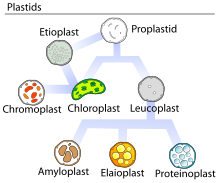Elaioplast
Appearance


Elaioplasts are a type of leucoplast that is specialized for the storage of lipids in plants.[1] Elaioplasts house oil body deposits as rounded plastoglobuli, which are essentially fat droplets.[2]
Being a variety of leucoplast, elaioplasts are non-pigmented and fall into the much broader organelle category of plant plastids. A different example of a storage-specialized leucoplast is the amyloplast, which stores starch.
See also
References
- ^ "elaioplast". gardenweb. Archived from the original on 2014-08-26.
{{cite web}}: Unknown parameter|deadurl=ignored (|url-status=suggested) (help) - ^ "mondofacto elaioplast". 2008-03-11.
